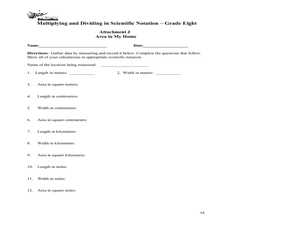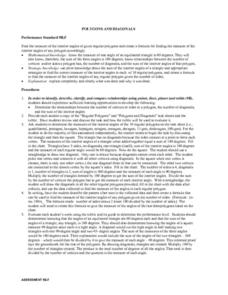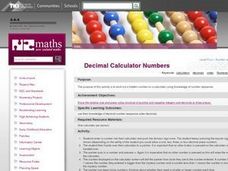Curated OER
Calculator Skills
An excellent presentation shows youngsters how to properly use a calculator, and how to use it to solve word problems. Learners are given tips on how to use the four basic operation buttons, then they try their hand at solving word...
Curated OER
Calculator Tricks
Kids love calcultor tricks. Youngsters like to form words that appear when you turn the calculator upside down. This trick is a bit more heady, in that it describes a unique phenomenon that holds true with virtually any four-digit...
Ohio Department of Education
Multiplying and Dividing in Scientific Notation - Grade 8
Here is really nice set of resources on scientific notation. Eighth and ninth graders explore the concept of multiplying and dividing in scientific notation. In this multiplying and dividing numbers in scientific notation instructional...
Curated OER
Calculator Puzzle Patterns
It's no secret that being able to competently use a calculator is an important skill. In this math lesson plan, young mathematicians learn how to use the counting constant function on their calculators to explore patterns and...
Curated OER
Introducing Calculators:
Students work in small groups to record how many pets each has, then use calculators to find the total number of pets owned by students in the entire group. They practice basic addition skills on a worksheet and with a calculator.
Curated OER
Calculator Game: Multiples of 3
In this calculator worksheet, students use the calculators to find multiples of 3 and put counters where they get the multiples of 3. Students complete this game when they have 4 counters in a row.
Curated OER
Polygons and Diagonals
Students practice measuring the interior angles of given regular polygons and create a formula for finding the measure of th interior angles of any polygon. They determine the relationships between the number of vertices's or sides in a...
Curated OER
The Closer I Get To You
Pupils explore the law of reflection. Through experimentation and problem solving, they collect and analyze data pertaining to reflection. The data is plotted on a graph and formulas for calculating the x and y values are evaluated.
Curated OER
What's My Number?
Fifth graders use AppleWorks to stamp a given number to the thousandths place. They read, write and order integers, whole numbers and rational numbers. They represent place value using concrete or illustrated models.
Curated OER
Calculator Art
Students identify the relationships among different parts of a nation's culture. They discover elements of mythology, legends and values.
Curated OER
Calculator Addition
First graders work with calculator to add, create an addition number sentence, and plug the number sentence into the calculator and get an answer.
Curated OER
Decimal Calculator Numbers
Fourth graders practice working out a hidden number on a calculator by utilizing number sequence in the advanced multiplicative stage seven. They enter a number into their calculator and push the division sign once and go from there.
Curated OER
Using the Calculator (Part II)
First graders watch a demonstration by their teacher to see how to use a calculator. They identify the numbers being used and input them into the calculator. On a worksheet, they record the answer and use coins to show the total.
Curated OER
Using Calculators And Spreadsheets
Students discuss the advantages of using calculators and spreadsheets in balancing checkbooks. They also identify the pros and cons of using these tools in adult education classrooms.
Curated OER
Number Patterns
Students discover patterns in sets of whole numbers using calculators. They write journal entries and orally report their findings to the class. They look for primes, squares, cubes and multiples.
Curated OER
Calculating Cats
First graders are introduced to calculators. They complete a variety of math problems using calculators and identify basic parts on a calculator.
Curated OER
Subtraction with Calculators
First graders demonstrate an understanding of subtracting one from a number of ten or less using manipulatives, work with calculators to solve subtraction problems, and create subtraction number sentences to solve on the calculator.
Smithsonian Institution
National Museum of American History: Slates, Slide Rules and Software
Did you learn to calculate using a 7-foot-long slide rule? Did you learn about the properties of numbers using brightly colored Cuisenaire rods? Ever wonder who invented the graph paper you used in geometry class? Go back to the...
Wyzant
Wyzant: Algebra Help
Heres a comprehensive review of the basics of algebra. WyzAnt includes lessons on varied topics, calculators that show step-by-step solutions, and interactive worksheets for practicing and testing your skills. Just choose a topic and use...
Savvas Learning
Prentice Hall Science & Math: Graphing Calculator Help
This site provides very complete help guides for a variety of graphing calculator models, complete with pictures and step-by-step instructions.
Great Idea Finder
The Great Idea Finder: Invention of the Hand Held Calculator
Learn about the invention of the small pocket or handheld calculator in the 1970's.
History of Computing Science
History of Computing Science: First Mechanical Calculator
Blaise Pascal, the seventeenth-century French mathematician, thinker, and scientist, built the first mechanical adding machine in 1642 based on a design described by Hero of Alexandria (2 CE) to add up the distance a carriage traveled.
Great Idea Finder
The Great Idea Finder: Adding Machine
The Great Idea Finder profiles the adding machine, invented by nineteen-year old mathematician Blaise Pascal in the year 1642.
Great Idea Finder
The Great Idea Finder: Blaise Pascal
Blaise Pascal (1623-1662), French philosopher, mathematician, and physicist, is considered one of the great minds in Western intellectual history. He also invented the first mechanical adding machine.
























